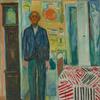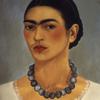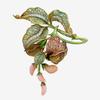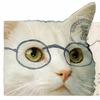Krannert Art Museum show brings together medieval manuscript collections
- CHAMPAIGN, Illinois
- /
- November 04, 2016
Medieval artisans created manuscripts adorned with intricate, colorful hand-drawn illustrations and embellished with gold leaf. Some of those images have since been cut from books, leaving the books missing parts of pages, and other manuscripts have been scraped clean of text.
Examples of such manuscripts – both intact and altered – will be displayed at Krannert Art Museum in an exhibition titled “Making and Breaking Medieval Manuscripts.” It will show how books were used and valued in the Middle Ages and since.
The exhibition opens Nov. 17 and goes through Feb. 11. It is the first exhibition specifically of medieval art at the museum since 1997, and it is the first time the medieval manuscripts have been displayed together. The manuscripts are owned in whole or in part by the University of Illinois and housed at Krannert Art Museum, the Rare Book and Manuscript Library, Spurlock Museum of World Cultures and the Newberry Library in Chicago.
“It’s a special opportunity. In general, medieval manuscripts are works mostly seen by scholars in a private, reserved setting,” said Maureen Warren, Krannert Art Museum’s curator of European and American art and co-curator of the exhibition.
The works on display range from the 12th century to the 20th century, but the vast majority were made between the 13th and 16th centuries. Most are books, but the exhibition also includes a large map and genealogical scroll showing the intermarriage of kings in France and England.
“These are some of the most valuable treasures from our collection,” said Anna Chen, the Rare Book and Manuscript Library’s curator of rare books and manuscripts and a co-curator of the exhibition.
The exhibition celebrates the life history of medieval manuscripts – how they were made and how they were broken apart by collectors, Warren said.
The fragments of books represent a practice now known as book breaking that started in the Middle Ages. In later centuries, the embellished images in manuscripts began to be treated like miniature paintings to be cut out and framed. The illustrations were considered the most attractive and valuable parts of medieval manuscripts. Pictures, initials and borders were often cut out and displayed on a wall, made into a collage, pasted in a scrapbook or used in a new book.
For example, an item from the Rare Book and Manuscript Library’s collection, the Lyte Book of Hours, has large initials “K.L.” on each page, colored red and blue and embellished with gold leaf. Several have been cut off the pages.
Books that fell out of fashion were often cut up so the images could be given as gifts to special visitors, Warren said. Sometimes the parchment was scraped down and reused for a new manuscript or for wrapping items.
The earliest object in the exhibition is a piece of a 10th century manuscript of Latin inscriptions that was cut out and then used to wrap the binding of another book.
“It’s been cut and it has holes in it and it’s dirty,” Warren said. “It’s not, on its own, a beautiful object. But it shows early medieval handwriting and how parchment was reused.”
While beautiful images were cut from books because they were valued, pages of text were recycled into new books because they were not valued in the same way, Chen said. Some of the types of texts that were reused include those seen as pagan, voided legal documents and liturgical music.
Cutting images out of manuscripts and distributing them was also a way to provide scholars with examples of art from different periods.
Among the items in the exhibition is a portfolio created by Otto Ege, a professor at the Cleveland Institute of Art at the turn of the 20th century. Ege wanted universities to have access to medieval texts, but he knew most could not afford them, Warren said. So Ege cut pages from a wide range of books and created portfolios featuring one page from each, accompanied by a description, so students could see pieces of a manuscript in person.
“His aims were noble, but his methods were controversial,” she said.
The Rare Book and Manuscript Library owns one of Ege’s portfolios that may have been part of his personal collection. Two leaves of it will be on view in the exhibition.
Book breaking is condemned now because it destroys the contextual evidence of a fragment, Chen said. The text and illustrations work closely together in medieval manuscripts, she said, and it can be difficult to know what an initial or image means when it is separated from the text.
Special care had to be taken to display the manuscripts, most of which were made from parchment.
“Parchment is a beautiful material, but it is very temperamental. It’s skin. It has pores. And with high humidity, it swells. That’s very bad for illuminated manuscripts. It can cause paint to flake off,” Warren said.
The cases in which the manuscripts will be displayed for the exhibition contain silica gel and the humidity will be carefully monitored. The exhibition will be limited to three months to further protect the manuscripts from environmental damage.

270x400_c.jpg)











100x100_c.jpg)





